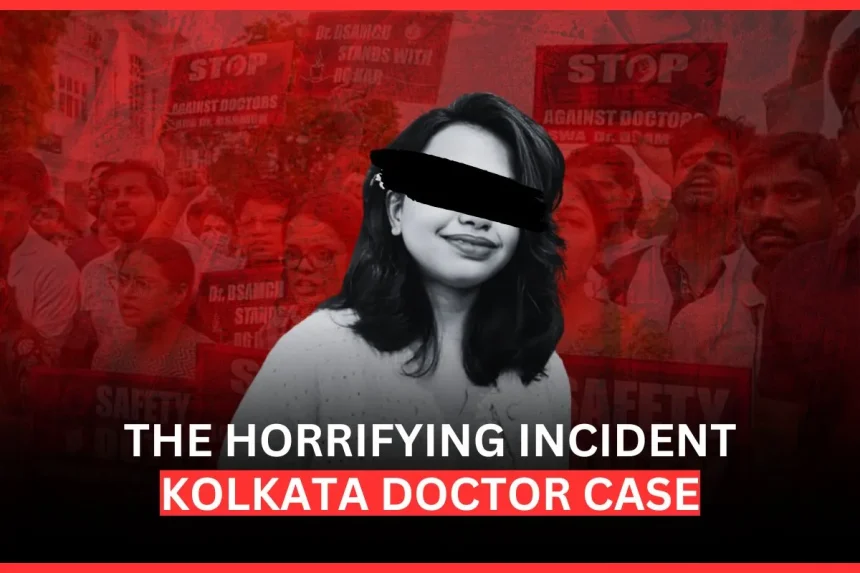The Kolkata doctor case has sent shockwaves through not only the medical community but also the entire nation. This incident, which occurred at R G Kar Medical College Hospital, has raised numerous questions about safety, accountability, and the systemic issues present in healthcare facilities. In this blog, we will explore the events surrounding the case, the reactions it has sparked, and the broader implications for women and medical professionals in India.
What Happened on the Day of the Crime
The events leading up to the tragic incident began with a call to the victim’s parents, who were informed that their daughter was seriously ill and needed immediate attention at the hospital. However, the situation escalated quickly. Just hours later, they received the devastating news that their daughter had allegedly committed suicide.
Upon their arrival, they were not allowed to see her for three hours. When they finally did, the condition of their daughter was shocking. She was found with severe injuries, including a broken pelvic girdle, and significant bruising and bleeding throughout her body. The injuries indicated a violent struggle, contradicting the narrative of suicide that was being pushed by the authorities.
The Victim’s Family’s Grief and Anguish
As the parents arrived at the hospital, they experienced a whirlwind of emotions—confusion, fear, and overwhelming grief. They had just spoken to their daughter hours before, and now they were confronted with the horrific reality of her death. The sight of their daughter’s body was traumatic; her clothing was torn, and the injuries suggested a violent attack rather than self-harm.
The family was not only dealing with their loss but also the chilling realization that something was gravely wrong. They began to suspect foul play, especially when they noticed discrepancies in the hospital’s account of events.
Post Mortem Findings and Initial Reactions
The post-mortem report revealed shocking findings. It indicated the presence of semen and other physical evidence that suggested sexual assault. This report contradicted the initial claims of suicide and fueled public outrage.
Medical professionals and students rallied together, demanding justice and transparency. Protests erupted across Kolkata, with calls for a thorough investigation into the circumstances surrounding the incident and accountability for those involved.
Arrest of the Suspects
As the public outcry grew, the police were pressured to act. The first suspect, Sanjoy Roy, was arrested shortly after the protests began. He was identified through CCTV footage that captured him near the scene of the crime.
During the investigation, evidence surfaced that suggested not only Roy but potentially others were involved in the crime. The narrative that had been pushed by the hospital authorities began to unravel, revealing deeper systemic issues of corruption and negligence.
Corruption and Cover-Ups in the Hospital
The hospital’s attempts to cover up the crime became evident as more allegations surfaced. Reports indicated that there were efforts to tamper with the crime scene, including renovations that could have destroyed crucial evidence. Such actions raised serious concerns about the integrity of the investigation.
Witnesses reported that a mob of approximately 7000 people attacked the hospital, causing destruction and chaos. This mob was allegedly composed of individuals who were either supporters of the accused or part of a larger network attempting to intimidate medical professionals and silence dissent.
The Role of Hospital Administration
Dr. Sandip Ghosh, the principal of the hospital, faced intense scrutiny for his handling of the situation. Allegations emerged that he had attempted to suppress information about the incident and protect the accused. His resignation was demanded by the protesting medical community, who felt that accountability was necessary for justice to be served.
Despite the public outcry, Ghosh’s position within the hospital seemed secure, raising further questions about the influence of politics and corruption within the institution.
Sexual Harassment in Medical Institutions
In the aftermath of this incident, discussions surrounding the safety of female doctors in hospitals gained momentum. Many medical professionals came forward, sharing their own experiences of harassment and discrimination in the workplace. This highlighted a toxic work culture that often leaves female doctors vulnerable and unsupported.
The medical community began to advocate for systemic changes to protect female staff and patients from harassment and violence. The introduction of a Central Protection Act was proposed to offer legal protections to medical professionals and ensure accountability for those who violate these protections.
The Need for Systemic Change
The Kolkata doctor case is not just an isolated incident; it reflects a broader issue of violence against women in India. The normalization of such crimes has desensitized society to the suffering of victims. The medical community’s fight for justice serves as a call to action for citizens to demand accountability and change.
It is crucial for the public to remain engaged and informed about these issues. By amplifying the voices of those affected and advocating for systemic reforms, citizens can help create a safer environment for medical professionals and patients alike.
How Citizens Can Help
As citizens, there are several ways to support the movement for justice and reform:
- Stay Informed: Keep up with developments in the case and related issues. Share credible information on social media to raise awareness.
- Support Protests: Participate in peaceful protests and demonstrations to show solidarity with those fighting for justice.
- Advocate for Change: Contact local representatives and demand legislative action to protect women in healthcare and other professions.
- Engage in Conversations: Discuss the importance of women’s safety with friends and family, helping to break the silence surrounding these issues.
Conclusion
The Kolkata doctor case has exposed serious flaws in the system, from hospital administration to societal attitudes toward violence against women. It is a stark reminder that change is necessary and urgent. By standing together and advocating for justice, we can create a safer environment for all, ensuring that such tragedies do not occur again.
As the fight for justice continues, it is essential for everyone to remain vigilant, informed, and engaged in the conversation. Together, we can work towards a future where women are safe in their workplaces and society at large.
Get more info: https://www.timelinetale.com/







